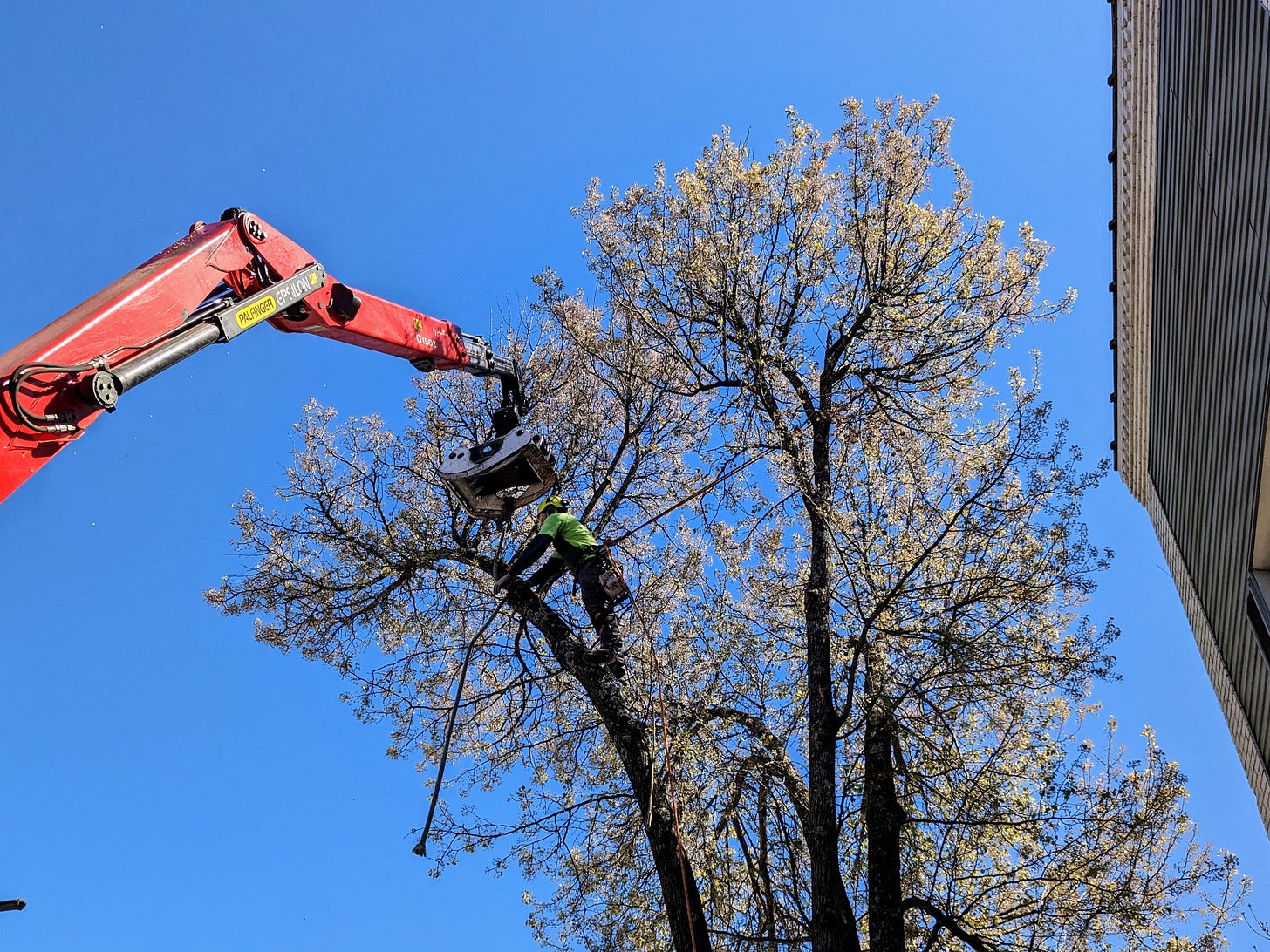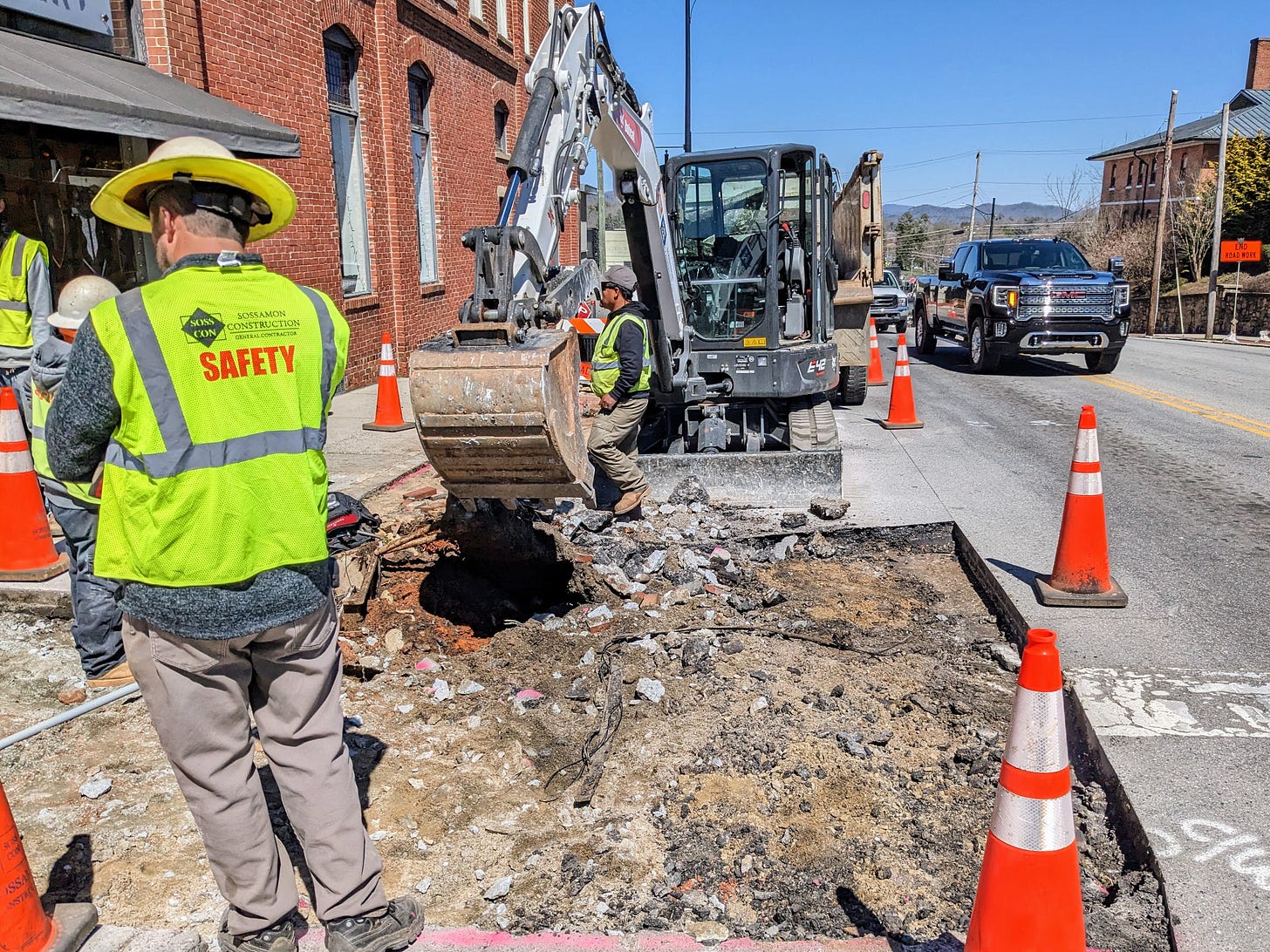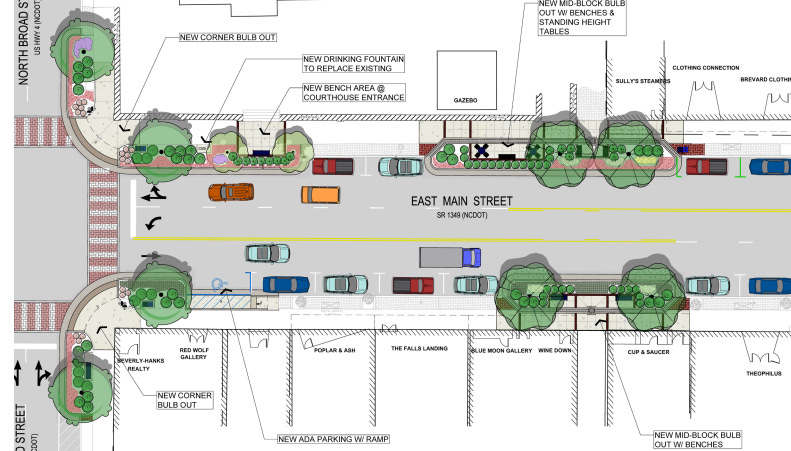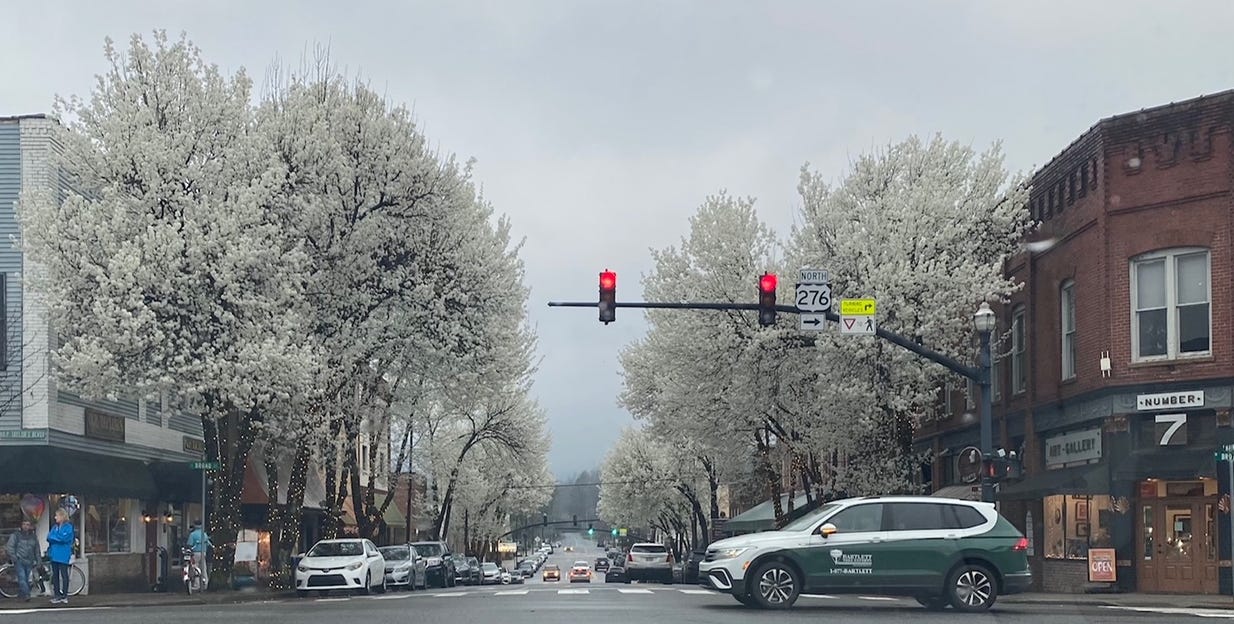Invasive Trees Fall in Biggest Downtown Upgrade in Four Decades
Brevard business owners welcomed improvements to landscaping, sidewalks and streets, but raised concerns about loss of parking and uncertain funding for future upgrades.

BREVARD — The Bradford pear trees on Brevard’s Main Street, like its pavement and sidewalks, are showing their age.
But when Bradfords get old, they announce it with a bang.
During a wind storm last March, one of the invasive pear trees — known for showy-if-stinky white flowers and a tendency to splinter spontaneously as they approach the end of their short lifespans — collapsed onto a parked truck.
That wasn’t the reason the city launched the current renovation of its downtown, which started on March 14 and is expected to continue through the rest of the spring. It was just a dramatic reminder that it needed to be done.
“As beautiful as these trees are and as much as they have graced our downtown for several decades, it’s just time to replace them,” Brevard Mayor Maureen Copelof said Monday afternoon.
She was standing on West Main Street shortly after visiting nearby Highland Books, whose owner, Leslie Logemann, had asked for more communication from the city about the temporary impact of a downtown business district transformed into a busy construction zone.
That is one downside to the $1.74-million project. Another is the loss of some streetside parking. Then there’s concern that, as has been the case with several previous versions of the Downtown Master Plan, lack of future funding will result in the bulk of the ambitious 2021 document seeing life only on paper.
This latest plan calls for, among other improvements, bike boulevards on side streets, pocket parks and landscaped “gateways” marking the city center’s boundaries — which were expanded to include several more blocks than earlier plans.
The ongoing first phase of that work, timed to coincide with a state Department of Transportation repaving project, will be limited to two blocks of Main, between Gaston and Caldwell streets.
But given that this is the very center of the city center and that more than 40 years have passed since the last big upgrade to downtown streets and sidewalks, the work is welcomed even by business owners concerned about its disruptions.
“I love that the city of Brevard is doing this project,” Logemann said Monday. “I think it’s going to be great for downtown.”

Ink Dried, Cones Went Up
The project’s most visible improvements will be traffic-calming curb extensions called bump outs planned for the middle of the blocks and the intersection of Main and Broad streets, said Becky McCann, the city’s communications coordinator.
Other features include sidewalk upgrades and stamped asphalt crosswalks, while the pears will be replaced with “native trees, including white fringe trees, American yellowwoods, Redmond American lindens, and sweetbay magnolia,” she wrote in a press release last week.
Meanwhile, the state will repave Main from Oaklawn Avenue to Gallimore Road after milling away layers of old asphalt — partly to ensure that the new downtown curbs will extend to their full height above the road surface, David Uchiyama, a DOT communications officer wrote in an email.
The state’s work, due to be completed in October, will also include replacement of wheelchair ramps that no longer comply with the Americans with Disabilities Act, he wrote.
Along with earlier replacement of downtown utility pipes, Copelof said, “this is really a massive upgrade both down below and up above.”
McCann described the city project as she walked past signs of its progress Monday — an arborist at work on the upper branches of a pear tree and backhoes digging trenches in streets and sidewalks to make way for the bump outs.
The City Council approved the payment to low bidder, Sossamon Construction of Gaffney, SC, at its March 6 meeting. The company didn’t just begin work eight days later, McCann said, it went at it full tilt.
This demolition of concrete and pavement on the north side of Main will be completed by the end of this week.
On April 3, demolition will begin on Main’s south side, which will force the temporary closure of “portions of the sidewalk . . . during the final phases,” according to an update McCann released on Wednesday, though access to affected businesses will be maintained with plywood ramps.
“Substantial completion” of the project is scheduled for May 25 and final completion before the end of June, McCann wrote earlier.
“The good news is, these guys are working so fast,” she said about Sossamon. “That ink was dry and the cones were down.”
Communications Breakdown?
Logemann was also impressed by the fast pace of construction, she said, but not always in a good way.
“Last week they started, which seemed great,” she said from near the window of her business on West Main Monday afternoon.
“But this morning we came in and the majority of the sidewalk had been closed,” she said, and “we sat here this morning and watched people across the street look over and then continue up the sidewalk because they didn’t think we were open.”
Business slumped by about 50 percent Monday, she said at that night’s City Council meeting.
“I am here to express that I am more than a little disappointed by the absence of communication with regard to this project,” she said, adding that it wasn’t until late in the afternoon that she received answers to two basic questions:
Would sidewalks be totally shut down, and could the city provide a schedule of the work to allow businesses to plan for disruptions?
There are no plans for total closures in front of Highland, McCann said, and on Wednesday she distributed the press release with the work schedule.
A question-and-answer session for business owners with Sossamon was scheduled for Friday at Council chambers between 8 and 10 am.
And Jeremy Owen, managing broker of the Allen Tate/Beverly-Hanks Realtors downtown location, said he was impressed by the outreach of Heart of Brevard staffers Nicole Bentley and Sara Jerome.
“They have stopped by my office multiple times to let us know, ‘Hey, this is how you are going to be impacted,’ ” he said. “The communication from Heart has been really solid.”
And Dee Dee Perkins, owner of D.D. Bullwinkel’s Outdoors on East Main, described her relief in seeing the start of long-overdue work such as replacing sidewalks and upgrading intersections.
“I couldn’t be more excited or more thrilled that those elements are happening,” she said.
Perennial Problems: Funding and Parking
But Owen and Perkins do have other concerns, including the loss of streetside parking.
McCann acknowledged that the landscaped bump outs come with a trade off. They slow traffic and create shorter, better-defined road crossings to improve pedestrian safety. The project will also preserve handicapped parking and loading zones, she said.
But, yes, it will result in the loss of 19 of the total of 160 downtown parking spaces on Main.
“Which is significant,” Perkins said, “because every space downtown is pretty crucial.”
She also said she appreciates the benefits of bump outs. So does Owen, especially because his office at the corner of Main and Broad provides an up-close view of the that busy intersection.
“I worry about the safety of those crosswalks,” he said.
But he also worries about parking, especially because the lost spaces are some of the most convenient. Even people who aren’t eligible to park in handicapped spaces can struggle to walk several blocks from off-street lots, he said. “My concern is: Do we have a plan for folks who have mobility issues to park downtown and be able to access those businesses?”
Parker Platt, president of the downtown PLATT architecture firm and a member of the city’s Downtown Master Plan Committee, was also happy to see the work begin. But he wants to make sure it continues.
“We’ve got this master plan developed now,” he said. “Let’s focus on how it’s going to get implemented and how it’s going to get implemented financially, and it doesn’t seem that there’s any true plan for that.”
That’s been the case for decades, said Perkins, a former Council member who served for many years on the Master Plan Committee.
“This is the fourth or fifth generation of a downtown master plan and those previous plans have never been implemented outside of a demonstration block that was probably done in 2010,” she said.
This block, in front of the Quotations Coffee Cafe, shows one peril of the partial implementation of plans. Because this earlier design’s work was never completed, the upgrades on the demonstration block will clash with the new improvements to the west.
And even paying for the first phase of the new plan proved to be a big challenge in the face of rising construction costs, said Assistant City Manager/Finance Director Dean Luebbe.
Plans for the current project originally included stormwater and streetscaping improvements in Times Arcade Alley, just off West Main.
That work was scrapped after bids came back higher than expected, and it is now estimated it would cost between $1.2 and $2 million as a standalone project, Luebbe said.
Even bids for the scaled-back job came in more than $400,000 higher than expected, according to documents presented at the March 6 meeting. Covering this cost required drawing funds from more than a half-dozen sources and draining the Downtown Master Plan Fund — $820,000, most of which was accumulated from an annual earmark of 2 cents of city property tax, or about $250,000 annually.
“It’s not enough,” Perkins said, who pointed out that previous, unsuccessful, applications for a federal infrastructure grant included money for downtown improvements. There are high hopes for finally receiving this grant after the city applied last month, but all this money would be devoted to another worthy priority, Perkins said, building the multi-use Ecusta Trail.
The city received $700,000 from the state for stormwater improvements in 2021. If the city receives a requested grant for a planned creek-bank stabilization project — now set to receive most of this state money — it could redirect the entire sum to Times Arcade, said City Manager Wilson Hooper.
But that would only cover about half the cost, he said, and though he named some other, smaller, potential funding sources if the City Council decides to proceed with the Times Arcade job, “we haven’t identified specifically where the money for that project is going to come from.”
“The Poor Bradford Pear”
Funding for the last major renovation project, said Al Platt, was supplemented by contributions from residents, including some owners of downtown properties.
In fact, that’s why he revised his original vision of “different (tree) species concentrated here and there around town” to include lines of trees on Main and Broad, said Platt, who drew the plan while working in Wilmington and before returning to Brevard in 1982 to form his namesake architectural firm.
Charles Campbell, the city’s mayor at the time, “said, ‘I can’t sell this because everybody is looking at the plan and they’re saying there’s not a tree in front of my building,’ ” Platt said.
His design also included brick strips in the sidewalks, providing visual relief from the slabs of concrete and easy removal to accommodate poles and utility repairs.
The trees were fitted with mostly long-gone iron grates that could be cut to accommodate growth. But Platt said he did not select the cherry and pear trees, the abundant blooms of which have become a hallmark of spring in downtown Brevard.
Copelof said she doesn’t know when the cherry trees, two of which will also be removed, or the pear trees were planted. Neither does McCann, who said she asked long-time employees this question without success. Neither does John Wayne Hardison, an arborist representative at Bartlett Tree Experts, the company that studied the pear trees after the collapse last spring.
The company determined that they needed to be replaced, he said, but not their age.
Platt doesn’t know either, though he has watched the Bradfords grow — two generations of them, as he recalls — from his office on West Main. Though he called them “weedlike,” he understands why they were chosen and why some residents will miss them.
“The poor Bradford pear, what a sad experience that has been across the country,” he said. “Those trees were so highly promoted.”
The Bradford is one of several varieties of the Callery pear, a native of east Asia, developed in the mid 20th century, according to a recent story on the agricultural science website, Morning Ag Clips.
They were touted for their blossoms, symmetrical shape and ability to survive harsh urban environments, the story said.
“Few trees possess every desired attribute,” the New York Times reported in 1964, according to Ag Clips, “but the Bradford ornamental pear comes unusually close to the ideal.”
One of those supposed attributes was sterility. Because Bradford pears are genetically identical, they cannot cross pollinate, the story said. But they can do so with other Callery varieties, and these hybrids proved to be, rather than sterile, “astonishingly fertile,” Ag Clips said, “and one of the most problematic invasive species in the eastern United States.”
Another failing of Bradfords emerged in recent decades: The joints between their long limbs and short trunks tend to rot after about 20 years.
But the trees are beautiful, Mike McCarthy, a county resident wrote in an email to NewsBeat asking why they were being removed.
“I like them and I’m sad to see them go,” he wrote.
So, in a way, is Platt, who saw poignance in their especially vivid display this year.
“They looked glorious about two weeks ago. These trees must have understood that their sentence had been handed down, that they were about to be executed, because they bloomed their heads off,” he said.
“It was something to see for a couple of days.”
Email: brevardnewsbeat@gmail.com






I support the decision to replace the Bradford Pear trees. They are beautiful — for a while — but they don’t last, and splinter and lose large limbs as they age (in less than two decades). I personally witnessed this in an Atlanta neighborhood where I used to live, Virginia Highlands, which has a similar few blocks of storefronts and sidewalks. The point came when these trees were constantly breaking apart — they were replaced by more appropriate decorative species. And now it looks great.
So happy to see them go and be replaced by natives. N.C. has a bounty for them and will replace with native species. Here's the link if anyone is interested- https://www.treebountync.com/